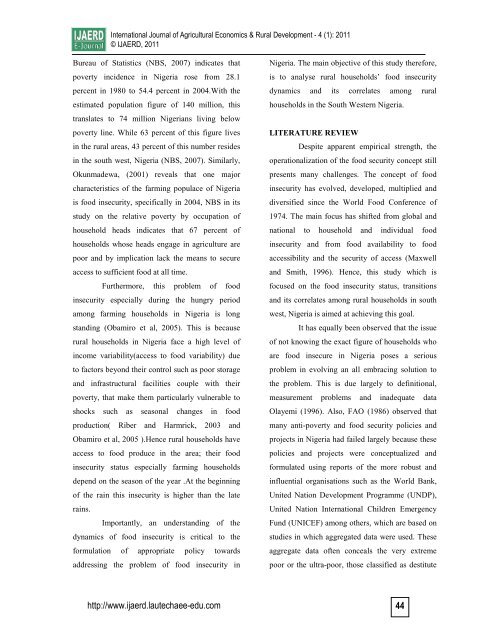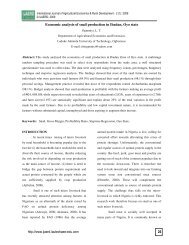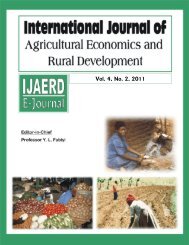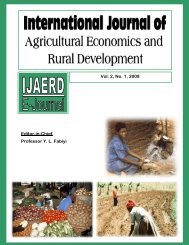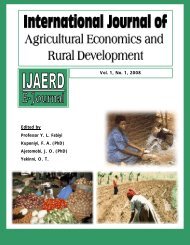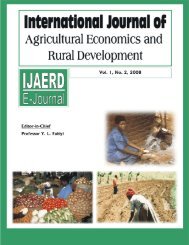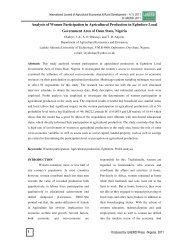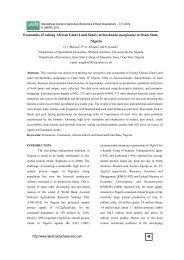Vol 4 No 1 2011
to download the whole journal - Lautechaee-edu.com
to download the whole journal - Lautechaee-edu.com
- No tags were found...
You also want an ePaper? Increase the reach of your titles
YUMPU automatically turns print PDFs into web optimized ePapers that Google loves.
International Journal of Agricultural Economics & Rural Development - 4 (1): <strong>2011</strong><br />
© IJAERD, <strong>2011</strong><br />
Bureau of Statistics (NBS, 2007) indicates that<br />
poverty incidence in Nigeria rose from 28.1<br />
percent in 1980 to 54.4 percent in 2004.With the<br />
estimated population figure of 140 million, this<br />
translates to 74 million Nigerians living below<br />
poverty line. While 63 percent of this figure lives<br />
in the rural areas, 43 percent of this number resides<br />
in the south west, Nigeria (NBS, 2007). Similarly,<br />
Okunmadewa, (2001) reveals that one major<br />
characteristics of the farming populace of Nigeria<br />
is food insecurity, specifically in 2004, NBS in its<br />
study on the relative poverty by occupation of<br />
household heads indicates that 67 percent of<br />
households whose heads engage in agriculture are<br />
poor and by implication lack the means to secure<br />
access to sufficient food at all time.<br />
Furthermore, this problem of food<br />
insecurity especially during the hungry period<br />
among farming households in Nigeria is long<br />
standing (Obamiro et al, 2005). This is because<br />
rural households in Nigeria face a high level of<br />
income variability(access to food variability) due<br />
to factors beyond their control such as poor storage<br />
and infrastructural facilities couple with their<br />
poverty, that make them particularly vulnerable to<br />
shocks such as seasonal changes in food<br />
production( Riber and Harmrick, 2003 and<br />
Obamiro et al, 2005 ).Hence rural households have<br />
access to food produce in the area; their food<br />
insecurity status especially farming households<br />
depend on the season of the year .At the beginning<br />
of the rain this insecurity is higher than the late<br />
rains.<br />
Importantly, an understanding of the<br />
dynamics of food insecurity is critical to the<br />
formulation of appropriate policy towards<br />
addressing the problem of food insecurity in<br />
Nigeria. The main objective of this study therefore,<br />
is to analyse rural households’ food insecurity<br />
dynamics and its correlates among rural<br />
households in the South Western Nigeria.<br />
LITERATURE REVIEW<br />
Despite apparent empirical strength, the<br />
operationalization of the food security concept still<br />
presents many challenges. The concept of food<br />
insecurity has evolved, developed, multiplied and<br />
diversified since the World Food Conference of<br />
1974. The main focus has shifted from global and<br />
national to household and individual food<br />
insecurity and from food availability to food<br />
accessibility and the security of access (Maxwell<br />
and Smith, 1996). Hence, this study which is<br />
focused on the food insecurity status, transitions<br />
and its correlates among rural households in south<br />
west, Nigeria is aimed at achieving this goal.<br />
It has equally been observed that the issue<br />
of not knowing the exact figure of households who<br />
are food insecure in Nigeria poses a serious<br />
problem in evolving an all embracing solution to<br />
the problem. This is due largely to definitional,<br />
measurement problems and inadequate data<br />
Olayemi (1996). Also, FAO (1986) observed that<br />
many anti-poverty and food security policies and<br />
projects in Nigeria had failed largely because these<br />
policies and projects were conceptualized and<br />
formulated using reports of the more robust and<br />
influential organisations such as the World Bank,<br />
United Nation Development Programme (UNDP),<br />
United Nation International Children Emergency<br />
Fund (UNICEF) among others, which are based on<br />
studies in which aggregated data were used. These<br />
aggregate data often conceals the very extreme<br />
poor or the ultra-poor, those classified as destitute<br />
http://www.ijaerd.lautechaee-edu.com 44


